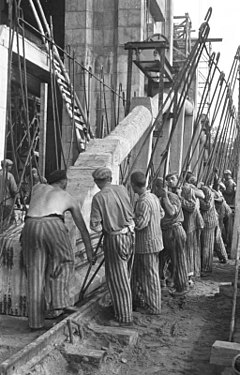
Back اقتصاد ألمانيا النازية Arabic Privreda Nacističke Njemačke BS Economia de l'Alemanya nazi Catalan Ekonomika nacistického Německa Czech Wirtschaft im Nationalsozialismus German Ekonomio en nazia Germanujo Esperanto Economía de la Alemania nazi Spanish Économie du Troisième Reich French Gospodarstvo Trećeg Reicha Croatian Նացիստական Գերմանիայի տնտեսություն Armenian
| Economy of Nazi Germany | |
|---|---|
 Prisoner work force in the construction of the Valentin submarine pens for U-boats, in 1944 | |
| Location | The Third Reich and German-occupied Europe; forced labor predominantly from Nazi-occupied Poland and the Nazi-occupied Soviet Union |
| Period | Great Depression and World War II (1933–1945) |
| Part of a series on |
| Nazism |
|---|
| Part of a series on |
| Economics |
|---|
Like many other nations at the time, Germany suffered the economic effects of the Great Depression, with unemployment soaring after the Wall Street Crash of 1929.[1] When Adolf Hitler became Chancellor of Germany in 1933, he introduced policies aimed at improving the economy. The changes included privatization of state owned industries, import tariffs, and an attempt to achieve autarky (national economic self-sufficiency). Weekly earnings increased by 19% in real terms from 1933 to 1939,[2] but this was largely due to employees working longer hours, while the hourly wage rates remained close to the lowest levels reached during the Great Depression.[3] In addition, reduced foreign trade meant rationing of consumer goods like poultry, fruit, and clothing for many Germans.[4]
The Nazis believed in war as the primary engine of human progress, and argued that the purpose of a country's economy should be to enable that country to fight and win wars of expansion.[5] As such, almost immediately after coming to power, they embarked on a vast program of military rearmament, which quickly dwarfed civilian investment.[6] During the 1930s, Nazi Germany increased its military spending faster than any other state in peacetime,[7] and the military eventually came to represent the majority of the German economy in the 1940s.[8] This was funded mainly through deficit financing before the war, and the Nazis expected to cover their debt by plundering the wealth of conquered nations during and after the war.[9] Such plunder did occur, but its results fell far short of Nazi expectations.[10] The Nazi economy has been described as dirigiste by several scholars.[11][12] Overall, according to historian Richard Overy, the Nazi war economy was a mixed economy that combined free markets with central planning; Overy describes it as being somewhere in between the command economy of the Soviet Union and the capitalist system of the United States.[13]
The Nazi government developed a partnership with leading German business interests, who supported the goals of the regime and its war effort in exchange for advantageous contracts, subsidies, and the suppression of the trade union movement.[14] Cartels and monopolies were encouraged at the expense of small businesses, even though the Nazis had received considerable electoral support from small business owners.[15]
Nazi Germany maintained a supply of slave labor, composed of prisoners and concentration camp inmates, which was greatly expanded after the beginning of World War II. In Poland alone, some five million people (including Polish Jews) were used as slave labor throughout the war.[16] Among the slave laborers in the occupied territories, hundreds of thousands were used by leading German corporations including Thyssen, Krupp, IG Farben, Bosch, Blaupunkt, Daimler-Benz, Demag, Henschel, Junkers, Messerschmitt, Siemens, and Volkswagen, as well as the Dutch corporation Philips.[17] By 1944, slave labor made up one-quarter of Germany's entire civilian work force, and the majority of German factories had a contingent of prisoners.[18]
- ^ Adam Tooze, The Wages of Destruction: The Making and Breaking of the Nazi Economy (2008)
- ^ Bry, Gerhard (1960). Wages in Germany 1871–1945. New Jersey: Princeton University Press. pp. 331, 362. ISBN 0-87014-067-1.
- ^ Bry, Gerhard (1960). Wages in Germany 1871–1945. New Jersey: Princeton University Press. pp. 235–236. ISBN 0-87014-067-1.
- ^ Evans, Richard J. "Business, Politics, and War." The Third Reich in Power. New York: Penguin, 2006. 392. Print
- ^ Tooze 2006, pp. 38.
- ^ Tooze 2006, pp. 55.
- ^ Tooze 2006, pp. 66.
- ^ Evans, Richard J., The Third Reich at War (New York: Penguin, 2008), p. 333.
- ^ Evans 2005, p. 345.
- ^ Tooze 2006, pp. 410–420.
- ^ Gross, Stephen G. (2018), Baranowski, Shelley; Nolzen, Armin; Szejnmann, Claus-Christian W. (eds.), "The Nazi Economy", A Companion to Nazi Germany (1 ed.), Wiley, pp. 263–279, doi:10.1002/9781118936894.ch16, ISBN 978-1-118-93688-7, retrieved January 6, 2023
- ^ Berend, Ivan T. (2016). An Economic History of Twentieth-Century Europe: Economic Regimes from Laissez-Faire to Globalization. Cambridge University Press. p. 91. ISBN 978-1-107-13642-7.
- ^ Overy, Richard (2012) [1995]. Why The Allies Won. London: Random House. p. 252. ISBN 978-1-84595-065-1.
- ^ Tooze 2006, pp. 101–114.
- ^ William L. Shirer, The Rise and Fall of the Third Reich: A History of Nazi Germany, New York, Simon & Schuster, 1960, pp. 231–232
- ^ Cite error: The named reference
bibula-13530was invoked but never defined (see the help page). - ^ Cite error: The named reference
Buggelnwas invoked but never defined (see the help page). - ^ Cite error: The named reference
allenwas invoked but never defined (see the help page).
© MMXXIII Rich X Search. We shall prevail. All rights reserved. Rich X Search